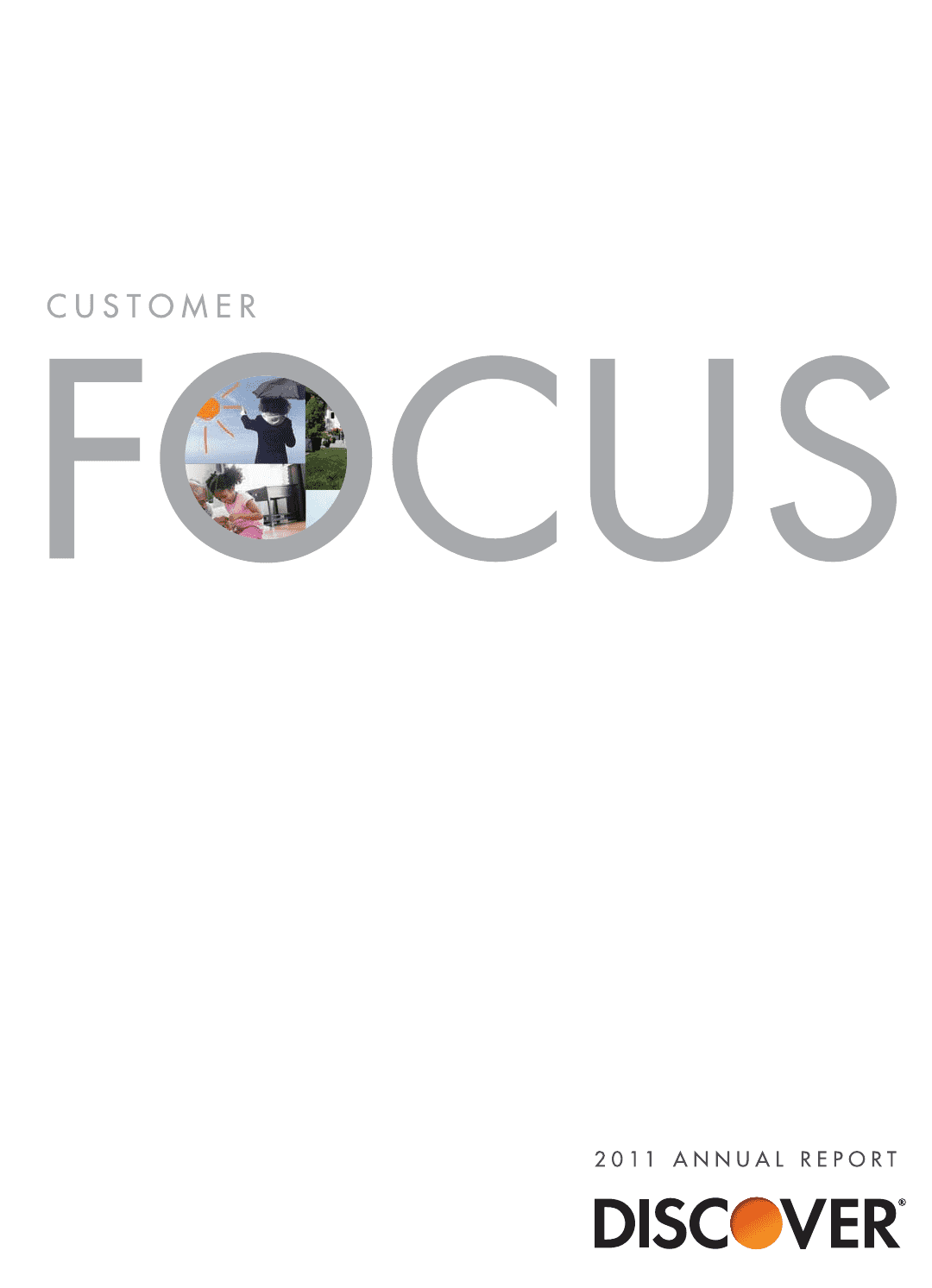Discover 2011 Annual Report Download
Download and view the complete annual report
Please find the complete 2011 Discover annual report below. You can navigate through the pages in the report by either clicking on the pages
listed below, or by using the keyword search tool below to find specific information within the annual report.
-

1
-
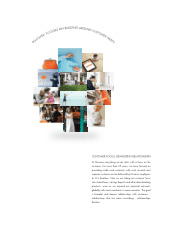
2
-
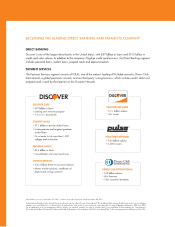
3
-
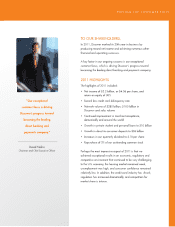
4
-
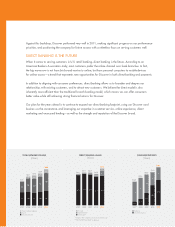
5
-
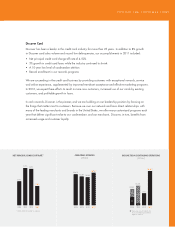
6
-
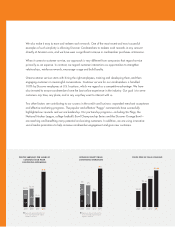
7
-
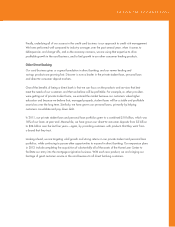
8
-
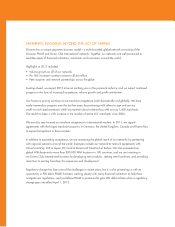
9
-

10
-
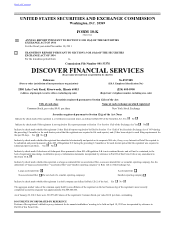
11
-

12
-

13
-

14
-

15
-

16
-

17
-

18
-

19
-

20
-

21
-

22
-

23
-

24
-

25
-

26
-

27
-

28
-

29
-

30
-

31
-

32
-

33
-

34
-

35
-

36
-

37
-

38
-

39
-

40
-

41
-

42
-

43
-

44
-

45
-

46
-

47
-

48
-

49
-

50
-

51
-

52
-

53
-

54
-

55
-

56
-

57
-

58
-

59
-

60
-

61
-

62
-

63
-

64
-

65
-

66
-

67
-

68
-

69
-

70
-

71
-

72
-

73
-

74
-

75
-

76
-

77
-

78
-

79
-

80
-

81
-

82
-

83
-

84
-

85
-

86
-

87
-

88
-

89
-

90
-

91
-

92
-

93
-

94
-

95
-

96
-

97
-

98
-

99
-

100
-

101
-

102
-

103
-

104
-

105
-

106
-

107
-

108
-

109
-

110
-

111
-

112
-

113
-

114
-

115
-

116
-

117
-

118
-

119
-

120
-

121
-

122
-

123
-

124
-

125
-

126
-

127
-

128
-

129
-

130
-

131
-

132
-

133
-

134
-

135
-

136
-

137
-

138
-

139
-

140
-

141
-

142
-

143
-

144
-

145
-

146
-

147
-

148
-

149
-

150
-

151
-

152
-

153
-

154
-

155
-

156
-

157
-

158
-

159
-

160
-

161
-

162
-

163
-

164
-

165
-

166
-

167
-

168
-

169
-

170
-

171
-

172
-

173
-

174
-

175
-

176
-

177
-

178
Table of contents
-
Page 1
-
Page 2
-
Page 3
-
Page 4
-
Page 5
... better value while still achieving strong ï¬nancial returns for Discover. Our plan for the years ahead is to continue to expand our direct banking footprint, using our Discover card business as the cornerstone, and leveraging our expertise in customer service, online experience, direct marketing...
-
Page 6
... rewards, service and online experience, supplemented by improved merchant acceptance and effective marketing programs. In 2012, we expect these efforts to result in more new customers, increased use of our cards by existing customers, and proï¬table growth in loans. In cash rewards, Discover...
-
Page 7
... have also invested to ensure cardmembers have the best online experience in the industry. Our goal is to serve customers any time, any place, and in any way they want to interact with us. Two other factors are contributing to our success in the credit card business: expanded merchant acceptance and...
-
Page 8
...over the long term. Similarly, we have grown our personal loans, primarily by helping customers consolidate and pay down debt. In 2011, our private student loan and personal loan portfolios grew to a combined $10 billion, which was 18% of our loans at year-end. Meanwhile, we have grown our direct-to...
-
Page 9
... to sign and service small- to mid-sized merchants while we maintain direct relationships with our top 1,400 merchants. The result has been a 41% increase in the number of active U.S. merchants since 2006. We are also very focused on merchant acceptance in international markets. In 2011, we signed...
-
Page 10
-
Page 11
... EXCHANGE ACT OF 1934 For the fiscal year ended November 30, 2011 TRANSITION REPORT PURSUANT TO SECTION 13 OR 15(d) OF THE SECURITIES EXCHANGE ACT OF 1934 For the transition period from to
Commission File Number 001-33378
DISCOVER FINANCIAL SERVICES
(Exact name of registrant as specified in...
-
Page 12
... names and service marks that we use in conjunction with the operation of our business, including, but not limited to: Discover®, PULSE®, Cashback Bonus®, Discover® More® Card, Discover® MotivaSM Card, Discover® Open Road® Card, Discover® Network and Diners Club International®. All other...
-
Page 13
...and small businesses on the Discover Network and other consumer banking products and services, including personal loans, student loans, prepaid cards and other consumer lending and deposit products offered through our Discover Bank subsidiary. Our Payment Services segment includes PULSE, Diners Club...
-
Page 14
... also charge customers other fees, including fees for late payments, balance transfer transactions and cash advance transactions. We also offer various products and services in connection with our credit card business, such as Payment Protection, Identity Theft Protection, Wallet Protection, Credit...
-
Page 15
... reward as a credit to the balance of their student loan or as a direct deposit to a bank account. To encourage responsible credit management, certain CitiAssist loans are eligible for interest rate reductions after the borrower has made a specified number of on-time payments. Discover student loan...
-
Page 16
... The credit card, student loan, personal loan and deposit products issued through our Direct Banking segment require significant investments in credit risk management, marketing, customer service and technology, whereas the operation of the Discover Network and our Payment Services business requires...
-
Page 17
... decision-making processes. Upon approval of a customer's application, we assign a specific annual percentage rate ("APR") using an analytical pricing strategy that provides competitive pricing for customers and seeks to maximize revenue on a risk-adjusted basis. For our credit card loans, we...
-
Page 18
... and online. Targeted marketing efforts may include balance transfer offers, fee product offers and reinforcement of our Cashback Bonus and other rewards programs. Through the development of a large prospect database, use of credit bureau data and use of a customer contact strategy and management...
-
Page 19
... shop at well-known online merchants using their Discover card. Our personal and student loan customers can utilize our online account services to manage their accounts. Our student loan website also includes interactive tools that provide customers with advice on paying for college and calculators...
-
Page 20
... date on that statement. Neither cash advances nor balance transfers are subject to a grace period. Each consumer with an outstanding debit balance on his or her Discover card account must generally make a minimum payment each month. If a customer exceeds his or her credit limit as of the last day...
-
Page 21
...2011, with our largest merchant accounting for approximately 8% of that transaction volume. In order to increase merchant acceptance, Discover Network has sold the majority of its small and mid-size merchant portfolios to third-party merchant acquirers to allow them to offer a comprehensive payments...
-
Page 22
... making investments to further grow acceptance both domestically and internationally. In our payment services business, we compete with other networks for volume and to attract third-party issuers to issue credit, debit and prepaid cards on the Discover, PULSE and Diners Club networks. We generally...
-
Page 23
... to control access and prevent unauthorized disclosures. Our Discover, PULSE and Diners Club brands are important assets, and we take steps to protect the value of these assets and our reputation. Employees As of January 20, 2012, we employed approximately 11,650 individuals. Risk Management The...
-
Page 24
... issues to our Risk Committee as necessary. These risk management committees include the Asset/Liability Management Committee, the Capital Planning Committee, the Counterparty Credit Committee, the Discover Bank Credit Committee, the Discover Bank Pricing Committee, the Payment Services Steering...
-
Page 25
... practices and workplace safety; customer, products and business practices; technology; physical asset and data security; processing; financial and reporting; and external provider. Operational risk exposures are managed through a combination of business line management and enterprise-wide oversight...
-
Page 26
... States. Discover Bank, our main banking subsidiary, offers credit card loans, student loans and personal loans, as well as certificates of deposit, savings accounts and other types of deposit accounts. Discover Bank is chartered and regulated by the Office of the Delaware State Bank Commissioner...
-
Page 27
... "Risk Factors - We may be limited in our ability to pay dividends and repurchase our common stock," "Market for Registrant's Common Equity, Related Stockholder Matters and Issuer Purchases of Equity Securities," "Management's Discussion and Analysis of Financial Condition and Results of Operations...
-
Page 28
... accepts brokered deposits under a waiver from the FDIC may not pay an interest rate on any deposit in excess of 75 basis points over certain prevailing market rates. There are no such restrictions under the FDIA on a bank that is "well-capitalized." As of November 30, 2011, Discover Bank and Bank...
-
Page 29
... marketing, underwriting, pricing and billing. The CARD Act's restrictions on our ability to increase interest rates on existing balances to respond to market conditions and credit risk ultimately limits our ability to extend credit to new customers and provide additional credit to current customers...
-
Page 30
... in countries in which our networks operate or our cards are used, either directly or indirectly through regulation affecting Diners Club network licensees. Changes in existing federal, state or international regulation could increase the cost or risk of providing network services, change the...
-
Page 31
...thereto, she served as Executive Vice President, Payment Services since December 2008 and Executive Vice President and Chief Technology Officer since 1998. In addition, she was appointed to oversee the PULSE network in 2006. From 1993 to 1998, Ms. Offereins was at MBNA America Bank, most recently as...
-
Page 32
..., he served as Executive Vice President, Card Programs and Chief Marketing Officer since December 2008 and Executive Vice President, Discover Network since December 2003. From 2000 to 2003, Mr. Talwar was Managing Director for our international business. Mr. Talwar held a number of positions at...
-
Page 33
... in this annual report on Form 10-K. See "Special Note Regarding Forward-Looking Statements," which immediately follows the risks below. Economic conditions have had and could have a material adverse effect on our business, results of operations, financial condition and stock price. While certain...
-
Page 34
... practices, or the application thereof, may adversely affect our business, financial condition and results of operations," "Current and proposed regulation addressing consumer privacy and data use and security could inhibit the number of payment cards issued and increase our costs," and "Litigation...
-
Page 35
... enter into exclusivity arrangements, which affect PULSE's current business practices and may materially adversely affect its network transaction volume and revenue. Our transaction processing revenue was $180 million and $150 million for the years ended November 30, 2011 and 2010, respectively. The...
-
Page 36
... to increase interest rates on existing balances to respond to market conditions and credit risk ultimately limits our ability to extend credit to new customers and provide additional credit to current customers. Other CARD Act restrictions with respect to allocation of payments on accounts and...
-
Page 37
... to issue credit and debit cards and other card products on the Discover, PULSE and Diners Club networks. Competition with other operators of payment networks is generally based on issuer interchange fees, fees paid to networks (including switch fees), merchant acceptance, network functionality...
-
Page 38
... cards transacting in North America from the MasterCard acceptance network to the Discover Network in 2011. If we are unable to continue to offer acceptable North American merchant acceptance to Diners Club customers, we may experience decreased transaction volume, which would reduce our revenues...
-
Page 39
... our business, profitability and financial condition. Our success depends on our ability to manage our credit risk while attracting new customers with profitable usage patterns. We select our customers, manage their accounts and establish terms and credit limits using proprietary scoring models and...
-
Page 40
... probability of government support for large financial institutions such as Discover assumed by the rating agencies in their current credit ratings. If we are unable to continue to fund our assets through deposits or access capital markets on favorable terms, or if we experience an increase in our...
-
Page 41
... requirements, see Note 19: Capital Adequacy to our consolidated financial statements. Additionally, our regulators can adjust the requirements to be "wellcapitalized" at any time and have authority to place limitations on our deposit businesses, including the interest rate we pay on deposits. If we...
-
Page 42
... in the credit ratings of our securities could materially adversely affect our business and financial condition. We, along with Discover Bank, are regularly evaluated by the ratings agencies, and their ratings for our long-term debt and other securities, including asset-backed securities issued by...
-
Page 43
... revenue. A key element of our business strategy is to increase the usage of the Discover card by our customers, including making it their primary card, and thereby increase our revenue from transaction and service fees and interest income. However, our customers' use and payment patterns may change...
-
Page 44
... average balances and total revenue. Our transaction volume is concentrated among large merchants, and a reduction in the number of, or rates paid by, large merchants that accept cards on the Discover Network or PULSE network could materially adversely affect our business, financial condition...
-
Page 45
... acceptance of the Discover card internationally and expand our direct-toconsumer deposit business. Our financial condition, the level of our fraud charge-offs and other results of operations could be materially adversely affected if fraudulent activity were to significantly increase. High profile...
-
Page 46
... could materially adversely affect our transaction volumes, our revenues and/or our results of operations. Merchant defaults may adversely affect our business, financial condition, cash flows and results of operations. As an issuer and merchant acquirer in the United States on the Discover Network...
-
Page 47
...and New York Stock Exchange in our capacity as a public company. In addition, as our payments business has expanded globally through the acquisition of Diners Club, we are subject to government regulation in countries in which our networks operate or our cards are used, either directly or indirectly...
-
Page 48
... Developments." Current and proposed regulation addressing consumer privacy and data use and security could inhibit the number of payment cards issued and increase our costs. Regulatory pronouncements relating to consumer privacy, data use and security affect our business. In the United States, we...
-
Page 49
... market indices; losses in our investment portfolio; limits on our ability to pay dividends and repurchase our common stock; fraudulent activities or material security breaches of key systems; our ability to increase or sustain Discover card usage or attract new customers; our ability to attract new...
-
Page 50
... the United States, that are used to support our Diners Club operations, and one leased office that supports our Direct Banking segment. Item 3. Legal Proceedings For a description of legal proceedings, see Note 21: Litigation and Regulatory Matters to our consolidated financial statements. Item...
-
Page 51
...5. Market for Registrant's Common Equity, Related Stockholder Matters and Issuer Purchases of Equity Securities Common Stock Market Prices and Dividends Our common stock began trading "regular way" on the New York Stock Exchange ("NYSE") (ticker symbol DFS) on July 2, 2007. The approximate number of...
-
Page 52
...employee transactions that were made by us or on our behalf during the three months ended November 30, 2011.
Total Number of Shares Purchased as Part of Publicly Announced Plan or Program(1)
Period September 1- 30, 2011
Total Number of Shares Purchased
Average Price Paid Per Share
Maximum Dollar...
-
Page 53
... financial statements not included elsewhere in this annual report on Form 10-K. The selected financial data shown below for the year ended November 30, 2010 reflects a change in accounting principle as a result of the consolidation of the securitization trusts, which is more fully described in Note...
-
Page 54
...average equity Return on average assets Average stockholders' equity to average total assets
(1) (2) (3) (4) (5)
Amounts as of and for the years ended November 30, 2011 and 2010 include securitized loans as a result of the consolidation of the securitization trusts related to a change in accounting...
-
Page 55
...-adjusted numbers are useful to investors and for a reconciliation of these numbers, see "Management's Discussion and Analysis of Financial Condition and Results of Operations - Reconciliations of GAAP to Non-GAAP As-Adjusted Data."
For the Years Ended November 30, 2011(1) 2010(1) 2009 2008 (dollars...
-
Page 56
...as point of sale terminals at retail locations throughout the U.S. for debit card transactions. Diners Club is a global payments network of licensees, which are generally financial institutions, that issue Diners Club branded credit cards and/or provide card acceptance services. Our fiscal year ends...
-
Page 57
... trusts to third-party investors in the same line items in our results of operations as nonsecuritized credit card loan receivables and corporate debt. Additionally, we no longer record initial gains on new securitization activity since securitized credit card loans no longer receive sale accounting...
-
Page 58
...impact the consolidation of our trusts would have had if we had adopted Statements No. 166 and 167 retrospectively. Earnings Summary and Reconciliation
For the Year Ended November 30, 2009 As Reported Securitization Adjustments Managed Additional Adjustments Non-GAAP As-Adjusted
(A) (B)
(dollars in...
-
Page 59
... accounts.
Direct Banking Segment Summary and Reconciliation
For the Year Ended November 30, 2009 As Reported Securitization Adjustments Managed (dollars in thousands) Additional Adjustments Non-GAAP As-Adjusted
Interest income Credit card Private student loans PCI student loans Personal loans...
-
Page 60
Table of Contents
Loan Receivables Data and Reconciliation
As of and for the Year Ended November 30, 2009 Total Loan Receivables Loan portfolio 2008 (dollars in thousands) 2007
GAAP Adjustments for Statement No. 167 Non-GAAP As-Adjusted
Loan receivables
$ 23,625,084 27,229,062 $ 50,854,146 $ 23,...
-
Page 61
... Non-GAAP As-Adjusted
Delinquency rate (Over 90 Days)
GAAP Adjustments for Statement No. 167 Non-GAAP As-Adjusted
Delinquency rate (Loans not accruing interest)
GAAP Adjustments for Statement No. 167 Non-GAAP As-Adjusted
Discover Card Charge-offs
GAAP Adjustments for Statement No. 167 Non-GAAP As...
-
Page 62
... 90 days)
GAAP Adjustments for Statement No. 167 Non-GAAP As-Adjusted
Restructured loans (A)
GAAP Adjustments for Statement No. 167 Non-GAAP As-Adjusted
Delinquency Rate (Restructured Loans) (A)
GAAP Adjustments for Statement No. 167 Non-GAAP As-Adjusted
(A) Data not available for the years ended...
-
Page 63
Table of Contents
Average Balance Sheet Reconciliation
For the Year Ended November 30, 2009 Average Balances Average restricted cash Interest Income/ Expense (dollars in thousands)
Yield
GAAP Adjustments for Statement No. 167 Non-GAAP As-Adjusted
Average investment securities
- 2,438,438 2,...
-
Page 64
...Adjusted
Interest rate spread
GAAP Adjustments for Statement No. 167 Non-GAAP As-Adjusted
Amortization of balance transfer fees in interest income on credit card loans (dollars in millions)
GAAP Adjustments for Statement No. 167 Non-GAAP As-Adjusted
$ $
128 59 187
For the Year Ended November 30...
-
Page 65
...as increased acceptance by merchants in the U.S. and major international destinations for U.S. travelers. We are also targeting solid growth and strong returns in our private student and personal loan portfolios, while continuing to pursue other opportunities to diversify our direct banking business...
-
Page 66
...
Our payments business had strong volume growth in 2011. We continue to focus on investments to build brand awareness and acceptance globally through support of our Diners Club network and arrangements with other networks and merchant acquirers. Recently, we have been successful in developing...
-
Page 67
... Act. It is uncertain how PULSE's business practices, network transaction volume, revenue, and prospects for future growth, as well as the debit card market as a whole, may be impacted by the industry's competitive response to these new requirements. Capital and Liquidity Consistent with Reform Act...
-
Page 68
... in the financial markets and to hold "highly liquid assets" that would be sufficient to cover 30-day stressed net cash outflows under their internal stress scenarios. Covered companies also would be required to meet specified corporate governance requirements around liquidity risk management, to...
-
Page 69
... products and loan fee income. Payment Services. Our Payment Services segment includes PULSE, an automated teller machine, debit and electronic funds transfer network; Diners Club, a global payments network; and our third-party issuing business, which includes credit, debit and prepaid cards issued...
-
Page 70
... from data provided by licensees for Diners Club branded cards issued outside North America and is subject to subsequent revision or amendment. Represents gross proprietary sales volume on the Discover Network. Represents Discover card activity related to net sales, balance transfers, cash advances...
-
Page 71
...2010. Discover card sales volume was $100.1 billion for the year ended November 30, 2011, an increase of 8% as compared to the same period in 2010. This growth was driven primarily by an increase in spending by both new and existing customers partially due to increased marketing. Net interest margin...
-
Page 72
... from transactions on the PULSE network. Expenses were down $8 million primarily due to transaction processing cost reduction initiatives as well as a lower level of international marketing investments. Transaction dollar volume for the year ended November 30, 2010 was $152 billion, an increase of...
-
Page 73
... customer purchase activity and the terms of the current rewards programs. We generally recognize reward costs as a reduction of discount and interchange revenue in the consolidated statements of income. If management used a different estimate of forfeitures, our consolidated statement of financial...
-
Page 74
... such changes occur, the effect on our consolidated financial condition and results of operations can be significant. See Note 17: Income Taxes to our consolidated financial statements for additional information about income taxes. Purchased Credit-Impaired Loans The estimate of expected future cash...
-
Page 75
... of Contents
Earnings Summary The following table outlines changes in our consolidated statements of income for the periods presented (dollars in thousands):
For the Year Ended November 30, 2009 (Non-GAAP As-Adjusted 1) 2011 vs. 2010 increase (decrease) 2010 vs. 2009 increase (decrease)
2011
2010...
-
Page 76
... quarter of 2011, as well as growth in personal loans. For the year ended November 30, 2011, the decline in interest income from credit card loans was mostly driven by a decline in yield caused by an increase in promotional rate balances and a decrease in customers who carry a balance on their cards...
-
Page 77
...rate student loans in our loan portfolio for much of the year, lower rates earned on higher balances in our liquidity investment portfolio and higher rates paid on long-term borrowings, partially offset by lower deposit funding costs and an improvement in credit card yield. Yield on credit card loan...
-
Page 78
... of balance transfer fees for the years ended November 30, 2011, 2010 and 2009 respectively. Includes the impact of interest rate swap agreements used to change a portion of certain floating-rate credit card loan receivables to fixed-rates. Includes federal student loans held for sale. Includes...
-
Page 79
... Increase/(decrease) in net interest income due to changes in: Interest-earning assets: Rate Total Volume 2010 vs. 2009 Rate Total
Cash and cash equivalents Restricted cash Other short-term investments Investment securities Loan receivables: Credit card Personal loans Federal student loans Private...
-
Page 80
... made to loans held for sale, Discover business card, personal loans, federal or private student loans or other loans. See reconciliation in " - Reconciliations of GAAP to Non-GAAP As-Adjusted Data." Represents purchased credit-impaired private student loans which do not have a related allowance for...
-
Page 81
... Discover business card, personal loans, federal and private student loans or other loans. See reconciliation in " - Reconciliations of GAAP to Non-GAAP As-Adjusted Data." On December 1, 2009, upon adoption of the Financial Accounting Standards Board ("FASB") Statements No. 166 and 167, the Company...
-
Page 82
...See Note 6: Loan Receivables to our consolidated financial statements for more information regarding the accounting for charge-offs on PCI loans.
The net charge-off rate on our credit card loan receivables decreased 358 basis points for the year ended November 30, 2011 as compared to the year ended...
-
Page 83
... of credit quality at a point in time. Loan balances are considered delinquent when contractual payments on the loan become 30 days past due. Information related to loans 90 days or more delinquent and accruing interest is provided in Note 6: Loan Receivables to our consolidated financial statements...
-
Page 84
... improvement in 2010 as compared to 2009. Similar to 2011, the decline in delinquency rates for both credit card and personal loans is due to improvements in customer financial performance and proactive customer account management. Loan receivables not accruing interest at November 30, 2010...
-
Page 85
...earn discount revenue from fees charged to merchants with whom we have entered into card acceptance agreements for processing credit card purchase transactions. We earn acquirer interchange revenue from merchant acquirers on all Discover Network card transactions and certain Diners Club transactions...
-
Page 86
... per transaction is generally offset by increased volume due to broader acceptance. Transaction Processing Revenue Transaction processing revenue represents switch fees charged to financial institutions and merchants for processing ATM, debit and point-of-sale transactions over the PULSE network, as...
-
Page 87
... the loan portfolio, network acceptance and deposits, and the associated impacts on headcount and compensation. Increased marketing and business development costs were primarily driven by higher investments in new credit card account acquisitions and new originations in student and personal loans...
-
Page 88
... the Company's effective tax rate to the U.S. federal statutory income tax rate:
For the Year Ended November 30, 2011 2010 2009
U.S. federal statutory income tax rate U.S. state and local income taxes and other income taxes, net of U.S. federal income tax benefits Valuation allowance - capital loss...
-
Page 89
...as an additional source of funding. We access the asset-backed securitization market using the Discover Card Master Trust I ("DCMT") and the Discover Card Execution Note Trust ("DCENT"), through which we issue asset-backed securities both publicly and through private transactions. The DCMT structure...
-
Page 90
... See Note 7: Credit Card and Student Loan Securitization Activities to our consolidated financial statements for additional information regarding the structures of DCMT and DCENT and for tables providing information concerning investors' interests and related excess spreads at November 30, 2011. At...
-
Page 91
... underlying student loans will reduce the balance of these secured borrowings over time. Additional Funding Sources Private Asset-Backed Securitizations. We have access to committed undrawn capacity through privately placed assetbacked securitizations to support the funding of our credit card loan...
-
Page 92
..., liquid investment securities. Cash and cash equivalents are invested primarily in deposits with the Federal Reserve. Investment securities included credit card asset-backed securities of other issuers and U.S. Treasury, U.S. government agency and AAArated corporate debt obligations issued under...
-
Page 93
... future dividends and share repurchases will depend upon our results of operations, financial condition, capital levels, cash requirements, future prospects and other factors. In addition, banking laws and regulations and our banking regulators may limit our ability to pay dividends and make share...
-
Page 94
... expected future contributions to our pension and postretirement benefit plans, Discover Bank's agreement with Citi to purchase private student loans and the contingent liability associated with our equity method securities.
As of November 30, 2011 our consolidated statement of financial condition...
-
Page 95
... responses to those changes may influence customer payment rates, loan balances or deposit account activity. We may face higher-cost alternative sources of funding as a result, which has the potential to decrease earnings. Our interest rate risk management policies are designed to measure and...
-
Page 96
... the Public Company Accounting Oversight Board (United States), the consolidated statement of financial condition, and related consolidated statements of income, changes in stockholders' equity, and cash flows as of and for the year ended November 30, 2011 of the Company and our report dated January...
-
Page 97
...three years in the period ended November 30, 2011, in conformity with accounting principles generally accepted in the United States of America. As discussed in Note 2 to the consolidated financial statements, the Company adopted the accounting standards, "Accounting for Transfers of Financial Assets...
-
Page 98
...
DISCOVER FINANCIAL SERVICES Consolidated Statements of Financial Condition
November 30, 2011 November 30, 2010
(dollars in thousands, except share amounts) Assets Cash and cash equivalents Restricted cash Other short-term investments Investment securities: Available-for-sale (amortized cost...
-
Page 99
... Year Ended November 30, 2011 2010 2009 (dollars in thousands, except per share amounts)
Interest income: Credit card loans Other loans Investment securities Other interest income Total interest income Interest expense: Deposits Short-term borrowings Long-term borrowings Total interest expense Net...
-
Page 100
... comprehensive income Purchases of treasury stock Common stock issued under employee benefit plans Common stock issued and stock based compensation expense Dividends paid-common stock Balance at November 30, 2011
1,225 - - - 1,225 1,225)
$
480,517 - -
-
(dollars and shares in thousands...
-
Page 101
...and bank notes Proceeds from issuance of common stock Purchases of treasury stock Net increase in deposits Proceeds from acquisition of deposits Redemption of preferred stock Repurchase of warrant Dividend paid to Morgan Stanley Dividends paid on common and preferred stock Net cash provided by (used...
-
Page 102
...offers its customers credit cards, student loans, personal loans and deposit products. Through its DFS Services LLC subsidiary and its subsidiaries, the Company operates the Discover Network, the PULSE Network ("PULSE") and Diners Club International ("Diners Club"). The Discover Network is a payment...
-
Page 103
... on the Company's fair value measurements, financial condition, results of operations or cash flows. In April 2011, the FASB issued ASU No. 2011-03, Transfers and Servicing (Topic 860): Reconsideration of Effective Control for Repurchase Agreements. This ASU amends the sale accounting requirement...
-
Page 104
...accounting for transfers of financial assets. Under Statement No. 166, the trusts used in the Company's securitization transactions are no longer exempt from consolidation. Statement No. 167 prescribes an ongoing assessment of the Company's involvement in the activities of the trusts and the Company...
-
Page 105
... than 90 days but less than one year when purchased. Investment Securities. At November 30, 2011, investment securities consisted of credit card asset-backed securities issued by other institutions, U.S. Treasury and U.S. government agency obligations, corporate debt securities, mortgage-backed...
-
Page 106
... balance of an account is contractually past due if the minimum payment is not received by the specified date on the customer's billing statement. Delinquency is reported on loans that are 30 or more days past due. Credit card loans are charged off at the end of the month during which an account...
-
Page 107
... factors, such as current economic conditions, recent trends in delinquencies and bankruptcy filings, account collection management, policy changes, account seasoning, loan volume and amounts, payment rates and forecasting uncertainties. Similar to credit card loans, the Company does not evaluate...
-
Page 108
... computer software for internal use are capitalized. Amortization of capitalized costs begins when the software is ready for its intended use. Capitalized software is included in premises and equipment, net in the Company's consolidated statements of financial condition. See Note 8: Premises and...
-
Page 109
... in other assets, in the consolidated statements of financial condition. Interest related to purchased credit-impaired loans is discussed in Note 6: Loan Receivables. The Company recognizes fees (except annual fees, balance transfer fees and certain product fees) on loan receivables in interest...
-
Page 110
... discount revenue from fees charged to merchants with whom the Company has entered into card acceptance agreements for processing credit card purchase transactions. Discover card transaction volume was concentrated among the Company's top 100 merchants in 2011, with its largest merchant accounting...
-
Page 111
... trust of their contractual rate of return, the payment of servicing fees to the Company and reimbursement of credit card losses ("interest-only strip receivable"). The Company included its undivided seller's interest within loan receivables in the consolidated statements of financial condition...
-
Page 112
... Loan Corporation ("SLC"), which is now a wholly-owned subsidiary of Discover Bank and included in the Company's Direct Banking segment. The Company acquired SLC's ongoing private student loan business, which includes certain private student loans held in three securitization trusts and other assets...
-
Page 113
... student loan insurance policies covering loans in one of the three trusts. The bargain purchase gain is recorded in other income on the Company's consolidated statement of income. During the fourth quarter of 2011, the Company finalized its purchase accounting, which resulted in a decrease of...
-
Page 114
...) that are guaranteed by the Federal Deposit Insurance Corporation (FDIC). During the year ended November 30, 2011, commercial advances and other Community Reinvestment Act related loan funds were reclassified to be included in Other Consumer Loans within the statement of financial condition.
102
-
Page 115
... (dollars in thousands):
Amortized Cost Gross Unrealized Gains Gross Unrealized Losses Fair Value
At November 30, 2011 Available-for-Sale Investment Securities(1) U.S Treasury securities U.S government agency securities Credit card asset-backed securities of other issuers Corporate debt securities...
-
Page 116
... 12 months Fair Value Unrealized Losses
At November 30, 2011 Available-for-Sale Investment Securities U.S. Treasury securities U.S. government agency securities Credit card asset-backed securities of other issuers Corporate debt securities Held-to-Maturity Investment Securities State and political...
-
Page 117
... securities Available-for-sale-Fair Values (1) U.S Treasury securities U.S government agency securities Credit card asset-backed securities of other issuers Corporate debt securities Total available-for-sale investment securities Held-to-maturity-Fair Values (2) U.S. Treasury securities State...
-
Page 118
... are accounted for using the equity method of accounting, and are recorded within other assets, and the related commitment for future investments is recorded in other liabilities within the statement of financial condition. The portion of each investment's operating results allocable to the Company...
-
Page 119
... Discover Bank must purchase such loans from the trust before a claim may be filed.
Credit Quality Indicators. The Company regularly reviews its collection experience (including delinquencies and net charge-offs) in determining its allowance for loan losses. Credit card and closed-end consumer loan...
-
Page 120
... on customers' current balances and most recent rates. Amount also excludes federal student loans that are held for sale.
Net Charge-Offs:
For the Year Ended November 30, 2011 Net Charge-offs Net Charge-off Rate
Credit card loans: Discover card Discover business card Total credit card loans Other...
-
Page 121
...Less than 660 or No Score
Discover card(1) Discover business card(1) Private student loans (excluding PCI) (2) Personal loans
81% 89% 95% 97%
19% 11% 5% 3%
(1) (2)
During September 2011, the Company began using FICO scores derived from a more current credit scoring model as one factor to assess...
-
Page 122
...Personal loans Federal student loans Private student loans Other Total other consumer loans Total charge-offs Recoveries: Discover card Discover business card Total credit card loans Personal loans Private student loans Other Total other consumer loans Total recoveries Net charge-offs Balance at end...
-
Page 123
... table provides additional detail of the Company's allowance for loan losses and recorded investment in its loan portfolio (which excludes loans held for sale) by impairment methodology (dollars in thousands):
Credit Card Personal Loans Student Loans Other Loans Total
At November 30, 2011 Allowance...
-
Page 124
... the difference between the loan balance and the discounted present value of cash flows expected to be collected. Consistent with the Company's measurement of impairment of modified loans on a pooled basis, the discount rate used for credit card loans is the average current annual percentage rate it...
-
Page 125
... provides information on loans that entered a loan modification program during the fiscal year (dollars in thousands):
Number of Accounts Balances as of November 30, 2011
Accounts that entered a loan modification program during the period: Credit Card: Internal Programs External Programs Student...
-
Page 126
... end of each quarterly period (dollars in thousands):
For the year ended November 30, 2011 Aggregated Outstanding Balances Upon Default
Number of Accounts
Troubled debt restructurings that subsequently defaulted: Credit Card (1)(2): Internal Programs External Programs Student Loans Personal Loans...
-
Page 127
... table provides changes in accretable yield for the acquired loans for the year ended November 30, 2011 (dollars in millions):
For the Year Ended November 30, 2011
Balance at beginning of period Acquisition of The Student Loan Corporation Acquisition of the additional private student loan portfolio...
-
Page 128
...Credit Card and Student Loan Securitization Activities
Credit Card Securitization Activities The Company accesses the term asset securitization market through the Discover Card Master Trust I ("DCMT") and the Discover Card Execution Note Trust ("DCENT"), which are trusts into which credit card loan...
-
Page 129
...the investors in the trusts' debt. The carrying values of these restricted assets, which are presented on the Company's consolidated statement of financial condition as relating to securitization activities, are shown in the table below (dollars in thousands):
November 30, 2011 2010
Cash collateral...
-
Page 130
... securitization transactions, net of issuance discounts, as applicable. The following table summarizes certain cash flow information related to the securitized pool of loan receivables (dollars in millions):
For the Year Ended November 30, 2009
Proceeds from third-party investors in new credit card...
-
Page 131
... as secured borrowings and the trusts are treated as consolidated subsidiaries of the Company. Trust receivables underlying third-party investors' interests are recorded in purchased credit-impaired loans, and the related debt issued by the trusts is reported in long-term borrowings. The assets of...
-
Page 132
... of PULSE in January 2005, which was allocated to the Payment Services segment. Subsequent to the acquisition date, no adjustments have been made to the Company's goodwill balance. The Company conducted its annual goodwill impairment testing on June 1, 2011 and 2010, at which times management...
-
Page 133
...of Contents
10.
Deposits
The Company offers its deposit products, including certificates of deposit, money market accounts, online savings accounts and Individual Retirement Account (IRA) certificates of deposit to customers through two channels: (i) through direct marketing, internet origination...
-
Page 134
... SLC Private Student Loan Trusts Total Long-Term Borrowings-owed to securitization investors Discover Financial Services (Parent Company) Fixed rate senior notes due 2017 Principal value (including discount of $451) Fair value adjustment(3) Book value Fixed rate senior notes due 2019 Discover Bank...
-
Page 135
... to support the funding of its credit card loan receivables. As of November 30, 2011, the total commitment of secured credit facilities through private providers was $7 billion, of which $250 million had been used and was included in long-term borrowings at November 30, 2011. Access to...
-
Page 136
...net of estimated forfeitures, for the years ended November 30, 2011, 2010 and 2009, respectively. Restricted Stock Unit Activity. The following table sets forth the activity related to vested and unvested RSUs during the year ended November 30, 2011.
Number of Shares Weighted-Average Grant-Date Fair...
-
Page 137
.... The fair value is amortized on a straight-line basis, net of estimated forfeitures over the requisite service period. Each PSU is a restricted stock instrument that is subject to additional conditions and constitutes a contingent and unsecured promise by the Company to pay up to two shares of the...
-
Page 138
... model to estimate the fair value of each option at its date of grant. The fair value was amortized on a straight-line basis, net of estimated forfeitures, over the requisite service periods of the awards, which is generally the vesting period. Use of a valuation model requires management to make...
-
Page 139
...components (dollars in thousands):
Pension For the Years Ended November 30, 2011 2010 2009 Postretirement For the Years Ended November 30, 2011 2010 2009
Service cost, benefits earned during the period Interest cost on projected benefit obligation Expected return on plan assets Net amortization Net...
-
Page 140
... the assumptions used to determine net periodic benefit cost:
Pension For the Years Ended November 30, 2011 2010 2009 Postretirement For the Years Ended November 30, 2011 2010 2009
Discount rate Expected long-term rate of return on plan assets Rate of future compensation increases
5.64% 6.75...
-
Page 141
...-term rate of return on plan assets was estimated by computing a weighted average return of the underlying long-term expected returns on the different asset classes, based on the target asset allocations. Asset class return assumptions are created by integrating information on past capital market...
-
Page 142
... fair value hierarchy for the years ended November 30, 2011 and 2010.
For the Year Ended November 30, 2010 Level 1 Level 2 Level 3 Total Net Asset Allocation
Long-duration U.S fixed income fund Registered Investment Company - International equity fund Common Collective Trusts: International equity...
-
Page 143
.... Common Stock Issuance During the year ended November 30, 2009, the Company raised approximately $534 million in capital through the issuance of 60,054,055 shares of common stock, par value of $0.01, at a public offering price of $9.25 per share ($8.89 per share, net of underwriter discounts and...
-
Page 144
... gains on cash flow hedges, net of tax expense of $2,701 (3) Balance at November 30, 2011 $
- $ (113,572)
$
$
(1) (2) (3)
Represents the difference between the fair value and amortized cost of available-for-sale investment securities. Reflects adjustments to the funded status of pension...
-
Page 145
... loans as a result of the consolidation of the securitization trusts upon adoption of Statement No. 167 on December 1, 2009. See Note 2: Change in Accounting Principle for more information.
Total other income includes the following components (dollars in thousands):
2011 For the Years Ended...
-
Page 146
... the Company's effective tax rate to the U.S. federal statutory income tax rate:
For the Year Ended November 30, 2011 2010 2009
U.S. federal statutory income tax rate U.S. state and local income taxes and other income taxes, net of U.S. federal income tax benefits Valuation allowance - capital loss...
-
Page 147
... the Company's net deferred income taxes, which are included in other assets in the consolidated statements of financial condition, were as follows (dollars in thousands): November 30, 2011 2010 Deferred tax assets: Allowance for loan losses Compensation and benefits Customer fees and rewards State...
-
Page 148
...EPS (in thousands, except per share amounts):
For the Year Ended November 30, 2011 2010 2009
Numerator: Net income Preferred stock dividends Preferred stock accretion Net income available to common stockholders Income allocated to participating securities Net income allocated to common stockholders...
-
Page 149
...Insurance Corporation (the "FDIC"). Failure to meet minimum capital requirements can result in the initiation of certain mandatory and possibly additional discretionary actions by regulators that, if undertaken, could have a direct material effect on the financial position and results of the Company...
-
Page 150
...which the Company can terminate at any time and which do not necessarily represent future cash requirements, are periodically reviewed based on account usage, customer creditworthiness and loan qualification. Commitments to purchase private student loans. Prior to its acquisition by Discover Bank on...
-
Page 151
... investor interests in credit card asset-backed securities plus the principal amount of any other outstanding secured borrowings. The Company has recorded substantially all of the maximum potential amount of future payments in long-term borrowings on the Company's statement of financial condition...
-
Page 152
.... In most instances, a loss by the Discover Network is unlikely to arise in connection with payments on card transactions because most products or services are delivered when purchased, and credits are issued by merchants on returned items in a timely fashion, thus minimizing the likelihood of...
-
Page 153
... cases, a wide range of business activities), unspecified damages and/or the novelty of the legal issues presented. The outcome of pending matters could be material to the Company's consolidated financial condition, operating results and cash flows for a particular future period, depending on, among...
-
Page 154
... the Company would realize in a current market exchange. The use of different assumptions or estimation techniques may have a material effect on the estimated fair value amounts. The following table provides the estimated fair values of financial instruments (dollars in thousands):
November 30, 2011...
-
Page 155
... types, characteristics and expected repayment terms. The fair values of all loan receivables are estimated by discounting expected future cash flows using rates at which similar loans could be made under current market conditions. Derivative financial instruments. The Company's derivative financial...
-
Page 156
... were no transfers between Levels 1 and 2 within the fair value hierarchy for the years ended November 30, 2011 and 2010.
At November 30, 2011, amounts reported in credit card asset-backed securities issued by other institutions reflected senior-rated Class A securities having a par value of $255...
-
Page 157
.... Changes in Level 3 Assets and Liabilities Measured at Fair Value on a Recurring Basis (dollars in thousands)
Net Transfers Into and/ or (Out of) Level 3 Change in unrealized gains (losses) related to financial instruments held at November 30, 2011
For the Year Ended November 30, 2011
Balance at...
-
Page 158
... fair value hedges. Cash Flow Hedges. The Company uses interest rate swaps to manage its exposure to changes in interest rates related to future cash flows resulting from credit card loan receivables. These transactions are hedged for a maximum period of three years. The derivatives are designated...
-
Page 159
...within the statement of financial condition each is reported as of November 30, 2011 and 2010. See Note 22: Fair Value Disclosures for a description of the valuation methodologies of derivatives. (In thousands, except number of transactions):
November 30, 2011 Balance Sheet Location Accrued Expenses...
-
Page 160
..., and indicates where within the consolidated statements of income such impact is reported for the years ended November 30, 2011 and 2010 (dollars in thousands):
For the Year Ended November 30, Location Derivatives designated as hedges: 2011 2010
Interest Rate Swaps-Cash Flow Hedges: Gain (loss...
-
Page 161
...'s business activities are managed in two segments: Direct Banking and Payment Services. • Direct Banking. The Direct Banking segment includes Discover card-branded credit cards issued to individuals and small businesses and other consumer products and services, including personal loans, student...
-
Page 162
... a managed basis with a reconciliation to a GAAP presentation for the year ended November 30, 2009 (dollars in thousands): For the Year Ended November 30, 2011 Interest income Credit card Private student loans PCI student loans Personal loans Other Total interest income Interest expense Net interest...
-
Page 163
... of Contents
Managed Basis Direct Banking Payment Services Total Securitization Adjustment(1)
GAAP Basis Total
November 30, 2009 Interest income Credit card Private student loans Personal loans Other Total interest income Interest expense Net interest income (expense) Provision for loan losses...
-
Page 164
... securities to include separate annual financial statements.
Discover Financial Services (Parent Company Only) Condensed Statements of Financial Condition November 30, 2011 2010 (dollars in thousands)
Assets: Cash and cash equivalents Notes receivable from subsidiaries Investments in subsidiaries...
-
Page 165
Table of Contents
Discover Financial Services (Parent Company Only) Condensed Statements of Income For the Years Ended November 30, 2010 2009 (dollars in thousands)
2011
Interest income Interest expense Net interest income Dividends from subsidiaries Antitrust litigation settlement Other income ...
-
Page 166
... in loans to subsidiaries Maturities of investment securities Decrease (increase) in restricted cash - special dividend escrow Net cash (used for) provided by investing activities Cash flows from financing activities Proceeds from issuance of long-term borrowings and bank notes Maturity of long-term...
-
Page 167
... conditions, including the receipt of governmental approvals, are expected to close in February 2012. Cash Dividend. On January 19, 2012, we paid a cash dividend of $0.10 per share of common stock. 28. Quarterly Results (unaudited) (dollars in thousands, except per share data):
November 30, 2011...
-
Page 168
... for the Company. Our internal control over financial reporting is designed to provide reasonable assurance regarding the reliability of financial reporting and the preparation of financial statements in accordance with generally accepted accounting principles. There are inherent limitations to the...
-
Page 169
...and Director Compensation" "Compensation Discussion and Analysis" "2011 Executive Compensation" "Compensation Committee Report"
Item 12.
Security Ownership of Certain Beneficial Owners and Management and Related Stockholder Matters
Information relating to compensation plans under which our equity...
-
Page 170
... the years ended November 30, 2011, 2010 and 2009 Consolidated Statements of Changes in Stockholders' Equity for the years ended November 30, 2011, 2010 and 2009 Consolidated Statements of Cash Flows for the years ended November 30, 2011, 2010 and 2009 Notes to the Consolidated Financial Statements...
-
Page 171
...(d) of the Securities Exchange Act of 1934, the Registrant has duly caused this report to be signed on its behalf by the undersigned thereunto duly authorized.
Discover Financial Services (Registrant) By: /S/ DAVID W. NELMS
David W. Nelms Chairman and Chief Executive Officer
Date: January 26, 2012...
-
Page 172
... report has been signed below by the following persons on behalf of the Registrant and in the capacities indicated on January 26, 2012.
Signature
Title
/S/
DAVID W. NELMS
Chairman and Chief Executive Officer
David W. Nelms Executive Vice President, Chief Financial Officer and Chief Accounting...
-
Page 173
... the Sale and Purchase of the Goldfish Credit Card Business, dated February 7, 2008, among Discover Financial Services, Goldfish Bank Limited, Discover Bank, SCFC Receivables Corporation, and Barclays Bank Plc (filed as Exhibit 2.1 to Discover Financial Services' Current Report on Form 8-K filed on...
-
Page 174
... Statement on Form S-4 filed on November 27, 2007 and incorporated herein by reference thereto). Collateral Certificate Transfer Agreement, dated as of July 26, 2007 between Discover Bank, as Depositor and Discover Card Execution Note Trust (filed as Exhibit 4.4 to Discover Bank's Current Report...
-
Page 175
...2009, between Discover Card Execution Note Trust, as Issuer, and U.S. Bank National Association, as Indenture Trustee (filed as Exhibit 4.1 to Discover Bank's Current Report on Form 8-K filed on July 6, 2009 and incorporated herein by reference thereto). Discover Financial Services Change-in-Control...
-
Page 176
...Performance Stock Units Under Discover Financial Services Amended and Restated 2007 Omnibus Incentive Plan (filed as Exhibit 10.5 to Discover Financial Services' Quarterly Report on Form 10Q filed on April 8, 2011 and incorporated by reference thereto). Asset Purchase Agreement between Discover Bank...
-
Page 177
... Annual Report on Form 10-K for the year ended November 30, 2011. We own or have rights to use the trademarks, trade names and service marks that we use in conjunction with the operation of our business, including, but not limited to: Discover , PULSE, Cashback Bonus , Discover More Card, Discover...
-
Page 178
